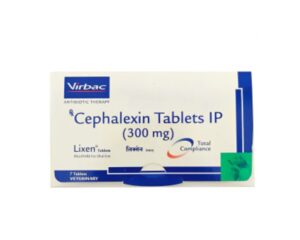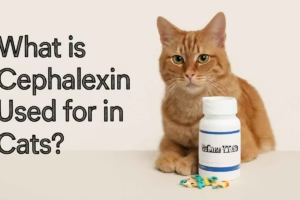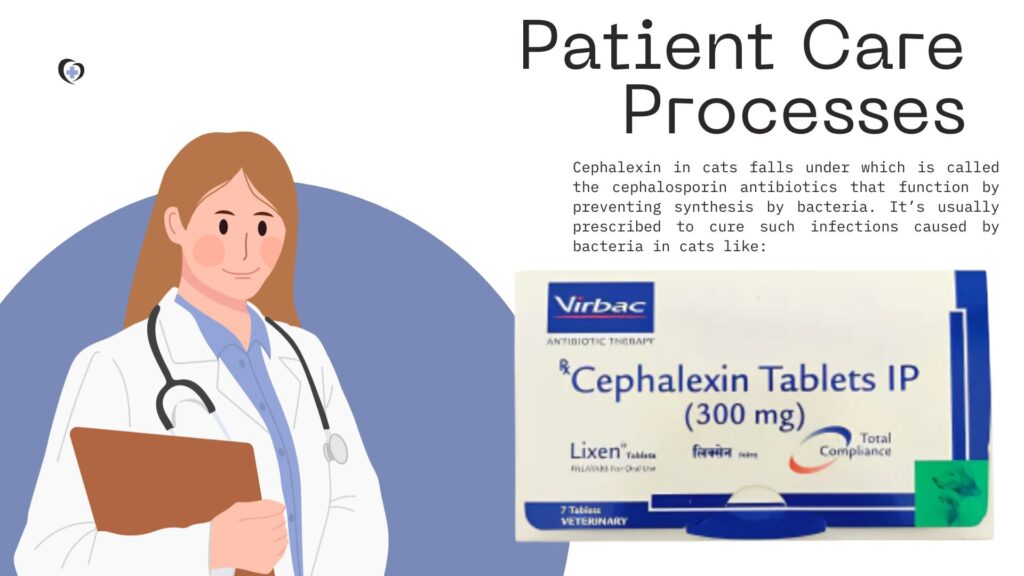What Is Cephalexin?
Cephalexin, also known as Keflex or Rilexine, is a go-to first-generation cephalosporin antibiotic used to treat skin infections in cats and dogs. It’s particularly effective against Staphylococcus pseudintermedius, a bacterium commonly responsible for staph infections. However, it’s also useful for treating urinary tract infections and other bacterial problems, often used extra-label.
For more on antibiotic treatments for pets, check out Simplicef 100mg for Dogs Guide.

This antibiotic targets mainly gram-positive and some gram-negative bacteria, as well as anaerobic bacteria. Cephalexin is generally prescribed for less severe infections, helping avoid the need for stronger, broad-spectrum antibiotics. By doing so, it reduces the risk of antibiotic resistance, which could lead to more difficult and life-threatening infections down the line.
What’s interesting is that Cephalexin isn’t just limited to cats and dogs. It’s also used in ferrets, reptiles, birds, and even horses, though it’s FDA-approved specifically for treating skin infections in dogs. Despite its off-label use, it remains a safe and effective treatment when prescribed by a vet.
When it comes to treating bacterial infections, Cephalexin proves to be a reliable option for cats, especially for less common conditions that might not have a typical treatment. While extra-label usage might seem unconventional, it’s a well-established practice that allows your pet to get the best care possible.
Overview of Cephalexin for Canines and Felines
- Cephalexin, also known as Keflex, Keftab, Biocef, and Rilexine, is a widely used antibiotic for treating bacterial infections in dogs and cats.
- It belongs to the cephalosporin class of drugs, working similarly to penicillin by disrupting the cell wall of bacteria, leading to their death and instability.
- As a first-generation cephalosporin, it effectively targets gram-negative and anaerobic organisms like Escherichia, Klebsiella, Proteus mirabilis, Pasteurella multocida, Streptococci, and Staphylococci.
- Cephalexin is orally administered, with peak serum levels achieved within two hours after ingestion.
- It’s not effective against certain bacteria like Aerobacter, Bacteroides, Enterococcus, Mycoplasma spp., Pseudomonas, or methicillin-resistant Staphylococci.
- The antibiotic will not work against fungi or viruses.
- Cephalexin is a prescription drug and can only be obtained through a veterinarian.
- Services like Chewy’s pet pharmacy allow you to order prescription food and medication for your pet, along with compound medications.
- With the Autoship option, you can ensure timely refills for your pet’s needs.
Learn more about alternative treatments like Marbofloxacin for Dogs and Clavamox Dosage for Dogs.
Brand Names and Other Names of Cephalexin
- Cefalexin, Cephalexin monohydrate, Cephalexin monohydrochloride, Keflex, Cephaforte, Celexin, Cepexin, Cephacillin, Ceporexin, Ilium, Rilexine, Ceporex, Cephacare, Cefaseptin, Cephorum, Cefabactin, Petalexin, Therios.
- Generic forms, Dista, Jurox, Virbac, Intervet, Animalcare LTD, Vetoquinol, Forum Animal Health, Le Vet Beheer, Alfamed, Ceva.
- The brand names may differ depending on the manufacturer or region, but all contain the same active ingredient: Cephalexin.
- Cephalexin is available in various formulations designed for both human and veterinary use.
What is Cephalexin used for in cats?
Cephalexin is a broad-spectrum antibiotic used by veterinarians to treat various bacterial infections in cats, most commonly for skin infections and soft tissue infections. It works by targeting the bacteria causing the infection and preventing their growth. Cephalexin is effective against a range of gram-positive bacteria and some gram-negative bacteria, making it a reliable option for these types of infections.
For alternatives, check out Cephalexin for Cats: Dosage Hacks & Treatment for more information.

While Cephalexin can also be used for urinary tract infections and respiratory tract infections, veterinarians often choose alternative antibiotics based on the specific infection and its severity. It’s important to ensure the correct dosage and follow the full treatment plan to avoid incomplete treatment or the development of antibiotic resistance.
What Are the Benefits of Cephalexin in Cats?
- Benefits of Cephalexin include its effectiveness against a wide range of bacteria.
- It works against different types of bacteria, making it versatile for various bacterial infections in cat.
- The medication starts to work within 2 hours, offering fast relief.
- Cephalexin has minimal side effects when given to cats, making it a safe option.
- It comes in multiple forms, including capsules, chewable tablets, and oral suspensions.
- Cephalexin is easy to administer, ensuring your pet gets the proper treatment.
For additional treatment options, read about Amoxicillin for Puppies or Tetracycline Antibiotics for Cats and Dogs.
How is Cephalexin given?
- Cephalexin is available in several forms: capsule, chewable tablet, oral suspension, and, in Canada, an oral paste.
- It can be given with or without food.
- If your pet vomits or feels unwell after taking it, try giving it a small amount of food.
- Shake the liquid form well and always measure doses carefully.
- Complete the course of antibiotics as directed by your veterinarian, even if your pet feels better.
- The medication will start working within one to two hours, but the effects may not be visible outwardly for a few days
For further guidance on pet medication administration, check out Gabapentin for Dogs: Dosage, Benefits & Side Effects.
To administer Cephalexin to a cat:
- Follow the veterinarian’s instructions carefully for the dose and dosing schedule.
- The medicine may be prescribed for several weeks, so make sure you understand how long to give it to your cat.
- If a dose is missed, give it as soon as you remember, unless it’s almost time for the next dose.
- If it’s close to the next dose, skip the missed dose and give the next dose on time; do not double up.
- Cephalexin can be administered with or without food.
- If your cat vomits or has digestive problems after a dose, try giving it with food or a treat.
How to administer cephalexin capsules:
To administer cephalexin capsules to your cat, it’s best to have a veterinary technician or other veterinary professional demonstrate the proper technique. They can show you how to administer the capsule correctly to ensure your cat takes the full dose. Cephalexin capsules should be stored at room temperature to maintain their effectiveness, so make sure to follow these storage guidelines carefully. Properly administering the capsules as instructed will ensure the best results in treating your cat’s infection.
How to administer cephalexin oral suspension:
- Shake the bottle well before measuring each dose.
- Use a calibrated oral syringe or another measuring device provided by your veterinarian to measure the dose.
- If you’re unsure of the proper technique for administering liquid medicine to your cat, ask a veterinary professional to demonstrate.
- Store cephalexin oral suspension in the refrigerator and throw it away 14 days after it was mixed.
What if I miss giving my pet the medication?
If you miss a dose of Cephalexin for your pet, give it as soon as you remember, and then continue with the regular dosing schedule. However, if it’s almost time for the next dose, it’s best to skip the missed dose and resume your usual schedule. Never give your pet two doses at once, as this could lead to potential side effects. Always stick to the prescribed dosing plan for the best results.
For more on dosage and medication schedules, read Sulfamethoxazole-Trimethoprim for Dogs.
Is Cephalexin safe for cats?
Cephalexin is generally considered safe for cats and doesn’t often cause significant side effects. When side effects do occur, they are typically minor and not a cause for concern. Veterinarians usually consider Cephalexin a good choice for treating deep skin infections in cats, especially when extended treatment is needed.
However, cats with allergies to cephalosporins should never be given this medication due to the risk of a hypersensitivity reaction. Additionally, if a cat is allergic to penicillin, cefamycin, or carbapenem antibiotics, there is a slight risk that they may also be allergic to cephalosporins, so caution is needed. Always inform the veterinarian if your cat has kidney disease, is pregnant, or is lactating, as these conditions may influence the treatment plan.
For more on antibiotic safety for pets, check out Is Clindamycin Safe for Dogs?.
Precautions and Side Effects
- Cephalexin is generally considered safe and effective when prescribed by a veterinarian for treating bacterial infections in cats.
- Side effects may occur in some animals, including cats, but these are typically rare and mild.
- The most common side effects of Cephalexin are vomiting shortly after administration and diarrhea. This is usually not a sign of a serious issue but indicates that the pet might be sensitive to this drug.
- Other side effects can include a decreased appetite, drooling, lethargy, and sometimes increased activity or excitement. Some cats may also develop a fever, although this is less common.
- Cephalexin should be given with food or a treat if vomiting occurs, to minimize stomach irritation.
- Cephalexin is not suitable for cats who have hypersensitivity or allergy to cephalosporins (like cefadroxil) or penicillin-based drugs such as amoxicillin and ampicillin due to the possibility of a cross-reaction.
- Allergic reactions to Cephalexin can include rash, hives, scratching, facial swelling, and irregular breathing. If any of these symptoms are observed, seek immediate assistance from your veterinarian.
- If your cat has a history of seizures, epilepsy, or kidney failure (renal issues), Cephalexin should be used with caution. These conditions may influence how your cat responds to the drug.
- High doses or accidental overdose of Cephalexin can lead to blood abnormalities, such as low white blood cell counts (neutropenia).
- In case of an overdose, gastrointestinal decontamination may be required, along with intravenous fluids to manage the symptoms.
- Always ensure Cephalexin is stored out of reach of children or curious pets, as accidental overdose can occur if ingested in large amounts.
- Cephalexin has a sulfur-like smell that may resemble cat urine. While unpleasant, this does not impact its effectiveness.
- The dosage, duration, and frequency of cephalexin treatment will depend on the underlying condition being treated and your pet’s response to the medication.
For more on side effects of pet medications, visit Side Effects of Vetoryl for Dogs.
Cephalexin dosage for cats
When it comes to cephalexin dosage for cats, the dosages may vary because it is used off-label in felines. The Merck Veterinary Manual recommends a standard dosage of 15-35 mg/kg, given by mouth every six to 12 hours. On the other hand, Plumb’s Veterinary Drug Manual suggests a dosage of 22 mg/kg every six hours, based on the cat’s body weight. These dosages are used to treat skin infections, soft tissue infections, urinary tract infections, and other susceptible infections, with the dosage strength varying according to the condition being treated.
For more on pet medication dosages, see Accurate Doxycycline Dosage Chart for Dogs.
Pet parents can purchase human versions of Cephalexin or use capsules and oral suspension formulations from a compounding pharmacy. The capsules come in strengths like 250 mg, 500 mg, and 750 mg, which may be too high for a cat, so it’s important to work with your vet to determine the right dosage. There are also chewable tablets available under the brand name Rilexine (for dogs), but the lowest dosage of 150 mg might be too much for many cats. Always consult your vet before adjusting the dosage to ensure it’s appropriate for your cat’s specific needs.
- Cephalexin is used off-label in cats so dosages may vary.
- The Merck Veterinary Manual recommends 15-35 mg/kg every six to 12 hours.
- Plumb’s Veterinary Drug Manual suggests 22 mg/kg every six hours.
- Dosage depends on the type of infection, such as skin infections, soft tissue infections, urinary tract infections, and susceptible infections.
- Human versions of Cephalexin can be purchased, along with oral suspension or capsules prepared by a compounding pharmacy.
- The capsules come in 250 mg, 500 mg, and 750 mg, but they may be too high for cats.
- Chewable tablets like Rilexine (for dogs) have a 150 mg dosage, which might be too much for cats.
- Always consult a veterinarian to determine the right dosage for your cat.
What if My Pet Takes Too Much, Overdoses, or Misses a Dose?
While Cephalexin in chewable form often smells and tastes appealing to dogs, it’s important to store it securely, especially in households with pets. Chewable tablets should be kept in their original prescription package or another tightly closed container to prevent accidental ingestion by your pet. To ensure safety, always store the medication in a secure location out of reach of your animals. If your pet accidentally consumes more Cephalexin than prescribed, it’s crucial to contact your vet or visit an emergency clinic immediately for advice.
If you missed a dose, you can still administer the dose if it’s close to the scheduled time.However, if it’s closer to the next dosing time, you should skip the missed dose entirely and give the next dose at the correct time. Remember, don’t double the dose as this can lead to potential complications. Always follow your vet’s instructions to ensure proper administration and to avoid any unintended issues.
Can I give my cat cephalexin every day?
Cephalexin is typically used as a daily treatment for cats, with pet parents administering two, three, or four doses a day for several days. It’s crucial to follow the full course of medication even if the symptoms start to resolve quickly, as stopping too early can leave the infection not fully eradicated. For common skin infections, the cat will need daily doses for about three weeks, but for more severe skin infections, it may take anywhere from eight to 12 weeks of consistent treatment. Fortunately, side effects are typically minimal when given at the prescribed dose, making it a reliable and manageable option for treating infections.
Are there any risk factors for this medication?
- Cephalexin should not be used in pets with a known hypersensitivity or allergy to cephalosporins.
- Use with caution in rabbits, small rodents, or pets sensitive to certain antibiotics, including penicillins, rapamycin, and carbapenems.
- Cephalexin should be adjusted for pets with kidney dysfunction, with lower doses potentially needed.
- Use with caution in pregnant or nursing pets.
- Always consult a veterinarian for guidance on the appropriate use of Cephalexin based on your pet’s specific health condition.
Are there any drug interactions I should be aware of?
There are no documented drug interactions for Cephalexin in animals, but caution should be exercised when administering Cephalexin alongside certain medications. Drugs like Probenecid (Benemid, Benuryl) and Warfarin (Coumadin, Jantoven, Panwarfin) may interact with Cephalexin, so it’s essential to inform your veterinarian about any other medications, including vitamins, supplements, or herbal therapies, your pet is taking before starting treatment. Always follow your vet’s guidance to ensure safe and effective use of Cephalexin alongside other therapies.
- There are no documented drug interactions for Cephalexin in animals, but caution is advised when used with certain medications.
- Medications like Probenecid (Benemid, Benuryl) and Warfarin (Coumadin, Jantoven, Panwarfin) may interact with Cephalexin. Always inform your veterinarian about any other drugs, vitamins, supplements, or herbal therapies your pet is taking.
How Do I Store Cephalexin?
Cephalexin should be stored properly to maintain its effectiveness. Chewable tablets, tablets, and capsules need to be protected from moisture and light, so keep them in a dry place at room temperature. The liquid version of Cephalexin should be kept in the fridge and used within 14 days. After this period, any unused amount should be disposed of to avoid potential loss of potency. Always follow the storage instructions to ensure your cat receives the full benefit of the medication.
Cephalexin alternatives for cats
When treating skin infections in cats, veterinarians often begin with topical antimicrobials rather than oral drugs like Cephalexin. These topical antiseptic treatments include options like medicated shampoos, mousses, creams, and gels, which contain bacteria-killing active ingredients such as chlorhexidine, benzoyl peroxide, ethyl lactate, and sodium hypochlorite. These treatments may be enough to eradicate the infection without needing pills. However, if the infection doesn’t improve or is more severe, veterinarians may opt for systemic antibiotics.
For more on alternative antibiotics for cats, visit Convenia for Dogs: Safety for All Breeds.
If Cephalexin is not effective or cannot be used, other first-generation cephalosporins like clindamycin and amoxicillin-clavulanate are commonly prescribed. Another option is cefovecin, a third-generation cephalosporin that’s administered through a single injection. If a sulfa drug is needed, sulfamethoxazole-trimethoprim may be an alternative. Any of these treatments can act as substitutes for Cephalexin if it’s not suitable or doesn’t work for your cat’s condition.
- Cephalexin
- Amoxicillin-clavulanate
- Cefovecin
- Sulfamethoxazole-trimethoprim
Summary
Cephalexin for Cats is a common antibiotic prescribed for skin infections in cats, targeting gram-positive and some gram-negative bacteria. It can also treat urinary tract infections and other bacterial conditions. Veterinarians may start with topical treatments like medicated shampoos or gels, but for severe infections, systemic antibiotics like cephalexin are often necessary.
Administering cephalexin involves following the veterinarian’s instructions on dose and dosing schedule. The medication starts to work within one to two hours, but improvements may take a few days. Side effects are usually minimal. If you miss a dose, give it as soon as you remember unless it’s close to the next dose. Cephalexin should be stored in a secure location and refrigerated if in liquid form, with any unused medicine discarded after 14 days. If it’s not effective, clindamycin or cefovecin may be alternatives.


